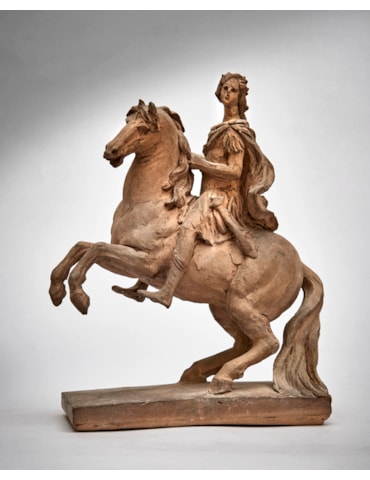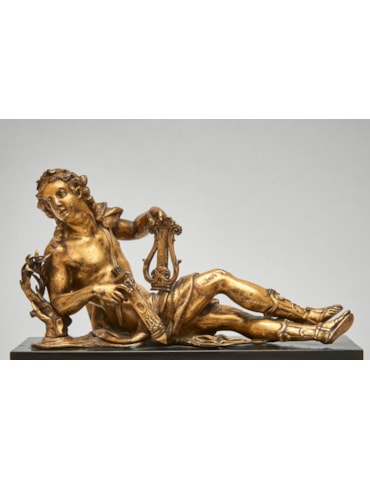Girolamo Campagna
Verona 1552 - Venice 1625
Chronos
Bronze statuette
Height: 21 cm / 10 in
Height: 21 cm / 10 in
ENQUIRIES
+44 (0)20 7259 0707
Condition and Facture: Cast by the lost wax method, the base metal is reddish in colour indicating a high copper content. Two small casting flaws in the underside of his right arm have both been filled with wax. The bronze section of the ‘shaft’ of the scythe held in Chronos’ right hand has been broken off after casting, both below and above his hand, while at his feet the base of the blade has at a later date been reworked/smoothed. Some traces of the original light golden lacquers are present where the later blacking has been rubbed. The hole in the centre of the base and notch in the blade of the scythe indicate that this statuette was probably the pinnacle figure of an andiron.
The present bronze, which compares stylistically directly with works documented by Campagna or his workshop, is to our knowledge the only known example of this model. Physiognomically typical of Campagna are the high broad forehead, the broad cheek bones and heavy lidded slightly bulging large eyes, the straight nose and small mouth. The modelling of the body, nipped-in waist and slightly heavy hips are also characteristic of this artist.
The most direct comparison is with the signed bronze statue of circa 1605 of St Anthony Abbot (Venice, San Giacomo di Rialto),1 who, although clothed, very closely resembles the facial type and stance of Chronos. On the 23 January 1589, Campagna received payment for the life-size Istrian stone statue of Mars that he had made for the roof balustrade of Sansovino’s Marciana library in the Piazzetta, Venice; it reproduces Chronos’ pose in reverse.2 For the same site, Campagna also made marble statues of Venus Marina, Jupiter, Juno, Pomona and Pluto, bronze reductions of which were produced in his workshop. The most popular of Campagna’s models made for the Marciana balustrade seems to have been the Venus of which a number of casts are known.3 Late sixteenth- and early seventeenth-century representations of Chronos are rare. Among the few bronze models known of the subject, a different model described as "Venetian, early seventeenth century" was sold at auction in 19914, and an inferior cast of it, in the Museo Civici, Padua has been optimistically attributed to the workshop of Tiziano Aspetti.5 Neither bronze approaches the quality of the present cast of Chronos.
Biographical Note:
The Veronese sculptor Girolamo Campagna6 is documented working with Danese Cattaneo in Venice in 1571. Upon Cattaneo's death in 1572, Campagna inherited his master’s drawings and plaster casts7 and took over the commission awarded to Cattaneo for the last marble relief, The Raising of a Youth, for St Anthony’s chapel in Il Santo, Padua; and a decade later (1580-1584) he redesigned Donatello’s high altar.
There followed a series of important commissions in Venice, including works in marble for the Doge’s Palace and for Sansovino’s library in the Piazzetta opposite. His greatest achievements in bronze are the monumental statues he created for the altars of Il Redentore and San Giorgio Maggiore between 1589 and 1593.
From then until 1605 Campagna worked mainly in marble on the tombs for Doges Cicogna and Grimani and a monument to Doge Loredan, but upon their completion Campagna returned again to the production of bronzes; his Annunciation for Castelvecchio, Verona dates from this period. His last major commission (1613-20) was for a series of marble saints and prophets for the Scuola Grande di San Rocco.
1. Wladimir Timofiewitsch, Girolamo Campagna, Studien zur venezianischen Plastik um das Jahr 1600, Munich, 1972, pl. 86; cat. 23, p. 296-298. Documented to 1603-7, probably cast January 1605.
2. Timofiewitsch, 1972 pl. 41-43; cat. 11, p. 252-253.
3. The example in the Metropolitan Museum of Art, New York (68.141.19) is inscribed I.C. on its base. See "La bellissima maniera", Alessandro Vittoria e la scultura veneta del Cinquecento, exh. cat. ed. Andrea Bacchi et al., Castello del Buonconsiglio, Trent, June-Sept 1999, cat. 92, p. 410-411, for bibliography and other versions of the model. I.C. appears on other bronzes attributed to Campagna's workshop; its meaning has yet to be established but it may refer to his workshop or to his brother Giuseppe; see Laura Camins, Renaissance & Baroque Bronzes from the Abbot Guggenheim Collection, exh. cat., M.H. de Young Memorial Museum, San Francisco, March - Sept 1988, cat. no. 13, p. 48-49 and 16, p. 54-56.
4. Sotheby's New York, 12 January 1991, lot 75.
5. Davide Banzato and Franca Pelegrini, Bronzi e plachette dei Musei Civici di Padova, Padua, 1989, cat. 77, p. 101.
6. B. Boucher in The Dictionary of Art, Macmillian 1996, vol. 5, pp. 531-4; and in The Genius of Venice 1500-1600, exhib. cat., Royal Academy of Arts, London 1983, pp. 359-360.
7. E. Rigoni, L'arte rinascimentale in Padova, 1970, pp. 232-233.
The present bronze, which compares stylistically directly with works documented by Campagna or his workshop, is to our knowledge the only known example of this model. Physiognomically typical of Campagna are the high broad forehead, the broad cheek bones and heavy lidded slightly bulging large eyes, the straight nose and small mouth. The modelling of the body, nipped-in waist and slightly heavy hips are also characteristic of this artist.
The most direct comparison is with the signed bronze statue of circa 1605 of St Anthony Abbot (Venice, San Giacomo di Rialto),1 who, although clothed, very closely resembles the facial type and stance of Chronos. On the 23 January 1589, Campagna received payment for the life-size Istrian stone statue of Mars that he had made for the roof balustrade of Sansovino’s Marciana library in the Piazzetta, Venice; it reproduces Chronos’ pose in reverse.2 For the same site, Campagna also made marble statues of Venus Marina, Jupiter, Juno, Pomona and Pluto, bronze reductions of which were produced in his workshop. The most popular of Campagna’s models made for the Marciana balustrade seems to have been the Venus of which a number of casts are known.3 Late sixteenth- and early seventeenth-century representations of Chronos are rare. Among the few bronze models known of the subject, a different model described as "Venetian, early seventeenth century" was sold at auction in 19914, and an inferior cast of it, in the Museo Civici, Padua has been optimistically attributed to the workshop of Tiziano Aspetti.5 Neither bronze approaches the quality of the present cast of Chronos.
Biographical Note:
The Veronese sculptor Girolamo Campagna6 is documented working with Danese Cattaneo in Venice in 1571. Upon Cattaneo's death in 1572, Campagna inherited his master’s drawings and plaster casts7 and took over the commission awarded to Cattaneo for the last marble relief, The Raising of a Youth, for St Anthony’s chapel in Il Santo, Padua; and a decade later (1580-1584) he redesigned Donatello’s high altar.
There followed a series of important commissions in Venice, including works in marble for the Doge’s Palace and for Sansovino’s library in the Piazzetta opposite. His greatest achievements in bronze are the monumental statues he created for the altars of Il Redentore and San Giorgio Maggiore between 1589 and 1593.
From then until 1605 Campagna worked mainly in marble on the tombs for Doges Cicogna and Grimani and a monument to Doge Loredan, but upon their completion Campagna returned again to the production of bronzes; his Annunciation for Castelvecchio, Verona dates from this period. His last major commission (1613-20) was for a series of marble saints and prophets for the Scuola Grande di San Rocco.
1. Wladimir Timofiewitsch, Girolamo Campagna, Studien zur venezianischen Plastik um das Jahr 1600, Munich, 1972, pl. 86; cat. 23, p. 296-298. Documented to 1603-7, probably cast January 1605.
2. Timofiewitsch, 1972 pl. 41-43; cat. 11, p. 252-253.
3. The example in the Metropolitan Museum of Art, New York (68.141.19) is inscribed I.C. on its base. See "La bellissima maniera", Alessandro Vittoria e la scultura veneta del Cinquecento, exh. cat. ed. Andrea Bacchi et al., Castello del Buonconsiglio, Trent, June-Sept 1999, cat. 92, p. 410-411, for bibliography and other versions of the model. I.C. appears on other bronzes attributed to Campagna's workshop; its meaning has yet to be established but it may refer to his workshop or to his brother Giuseppe; see Laura Camins, Renaissance & Baroque Bronzes from the Abbot Guggenheim Collection, exh. cat., M.H. de Young Memorial Museum, San Francisco, March - Sept 1988, cat. no. 13, p. 48-49 and 16, p. 54-56.
4. Sotheby's New York, 12 January 1991, lot 75.
5. Davide Banzato and Franca Pelegrini, Bronzi e plachette dei Musei Civici di Padova, Padua, 1989, cat. 77, p. 101.
6. B. Boucher in The Dictionary of Art, Macmillian 1996, vol. 5, pp. 531-4; and in The Genius of Venice 1500-1600, exhib. cat., Royal Academy of Arts, London 1983, pp. 359-360.
7. E. Rigoni, L'arte rinascimentale in Padova, 1970, pp. 232-233.




